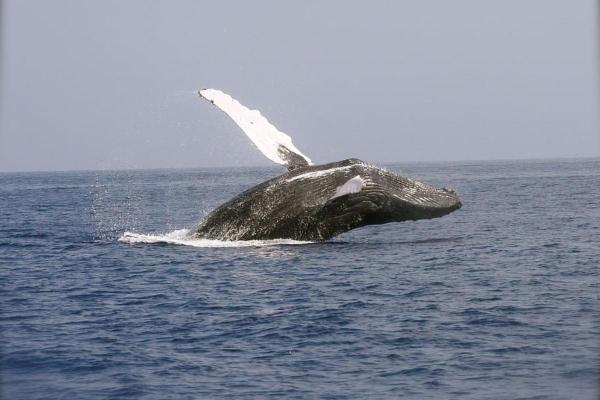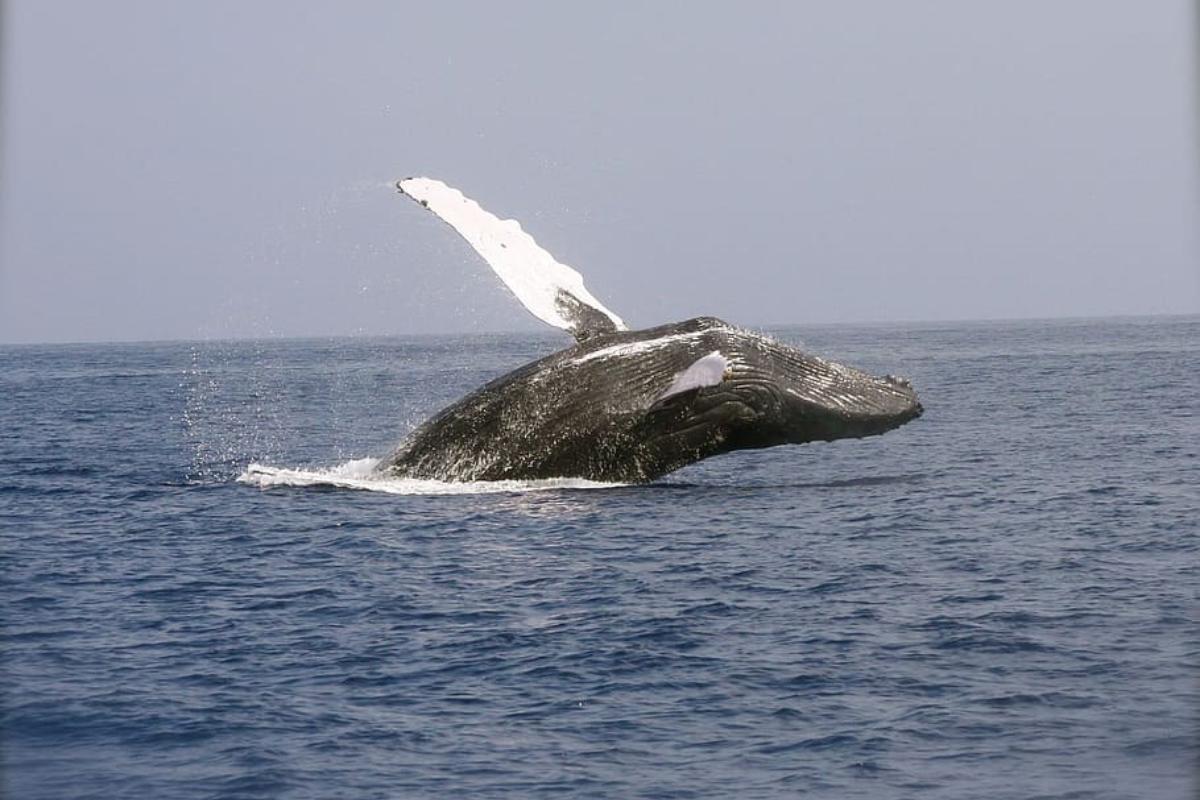Are Whales Mammals or Fish?


Whales are a group of marine mammals that have captured the fascination of humans for centuries. These magnificent creatures come in a variety of sizes, ranging from the small, toothed dolphins to the massive blue whale, which is the largest animal on Earth. However, despite their popularity, there is still confusion about whether whales are mammals or fish.
This article on AnimalWised examines the characteristics of whales and answers the question if whales are mammals or fish.
Is the whale a mammal or a fish?
Whales are mammals, not fish. Although they live in the water and have some physical similarities to fish, whales belong to a different group of animals altogether. There are several features of whales that may cause people to mistake them for fish, despite the fact that they are actually mammals. Some of these features include:
- Streamlined body shape: whales have a sleek and streamlined body shape that is similar to that of many fish. This body shape allows them to move through the water with great speed and agility.
- Flippers or fins: like many fish, whales have fins or flippers that they use to maneuver in the water.
- Living in water: since whales spend their entire lives in the water, people may assume that they are fish. However, unlike fish, whales must come to the surface to breathe air.
- Fish-like behavior: whales often swim in large groups and move in a coordinated manner, much like schools of fish.
Historical classification: in the past, whales were sometimes classified as fish due to their physical appearance and the fact that they live in the water. This classification persisted for centuries.
Language: in some languages, such as Korean and Japanese, the same word is used to describe both fish and whales. This can lead to confusion and make it more difficult for people to understand the differences between the two.
How are whales different from fish?
It should be noted that despite some individuals mistaking whales for fish, a plethora of scientific evidence confirms that whales are mammals. They possess distinct characteristics and adaptations that differentiate them from fish. Some of these are:
- Warm-blooded metabolism: like other mammals, whales are warm-blooded, which means they can maintain a constant body temperature regardless of the temperature of their environment.
- Hair: all mammals have hair at some point in their lives, and whales are no exception. Whales have hair as fetuses, but they lose it shortly after birth.
- Mammary glands: female whales have mammary glands that produce milk to feed their young.
- Lungs: like all mammals, whales breathe air through lungs.
- Four-chambered heart: whales have a four-chambered heart, which is a characteristic feature of all mammals.
- Live births: unlike most fish and reptiles, which lay eggs, whales give birth to live young.
- Warm-blooded muscles: whales have warm-blooded muscles, which allows them to swim fast and dive deep.
- Ear bones: whales have three small ear bones, called the malleus, incus, and stapes, which are similar to the bones found in the ears of other mammals.
- Diaphragm: whales have a muscular diaphragm that helps them breathe by contracting and relaxing to move air in and out of their lungs.
In addition to whales, several other animals that live in aquatic environments are also considered marine mammals, including seals, fur seals, sea lions, dugongs, manatees, walruses, sea otters, and even polar bears. To learn more about these fascinating creatures, check out our comprehensive list of marine mammals.

Why is the whale a mammal?
Whales are classified as mammals due to their shared anatomical and physiological characteristics with this group, as well as the strong molecular evidence confirming their evolutionary origin from terrestrial mammals.
Life on Earth initially evolved in the ocean, where the majority of biodiversity first emerged. As certain conditions changed in the terrestrial environment, animals began transitioning and conquering land. Invertebrates were the first to do so, followed by amphibians, which were the link between sea and land animals.
Whale ancestors were originally terrestrial artiodactyl animals, meaning they had hooves and an even number of toes to support their weight. They belonged to the same order as giraffes, camels, pigs, wild boars, and hippos.
About 50 million years ago, some of these land-dwelling mammals began to evolve adaptations for life in the water. Over time, these adaptations became more pronounced, and eventually, the ancestors of modern whales became fully aquatic animals. This evolutionary process took millions of years and involved many intermediate forms that are now extinct.
From this lineage emerged the two groups of modern cetaceans: the baleen whales (Mysticeti) and the toothed whales, dolphins, and sperm whales (Odontoceti).
Check out this article to learn about the largest whales in the world and their incredible sizes.
Are all whales mammals?
Yes, all whales are mammals, and they are taxonomically classified within the order Cetacea. This order includes two main suborders of whales based on their physical and behavioral characteristics: baleen whales (Mysticeti) and toothed whales (Odontoceti). These suborders include different families, genera, and species of whales, but all of them share the same biological features that define them as mammals.
Mysticeti
The Mysticeti suborder includes the baleen whales, which have baleen plates instead of teeth, two blowholes, and a symmetrical skull. These whales are typically larger than the toothed whales and primarily feed on small planktonic animals. There are four families in the Mysticeti suborder:
- Balaenidae: this family includes the bowhead whale (Balaena mysticetus) and the right whales (Eubalaena glacialis, Eubalaena japonica, Eubalaena australis).
- Balaenopteridae: this family includes the rorquals, such as the blue whale (Balaenoptera musculus), fin whale (Balaenoptera physalus), humpback whale (Megaptera novaeangliae), and minke whale (Balaenoptera acutorostrata).
- Eschrichtiidae: this family includes the gray whale (E. robustus).
- Neobalaenidae: this family includes the pygmy right whale (Caperea marginata).
Odontoceti
The Odontoceti suborder includes the toothed whales, which have teeth, a single blowhole, and an asymmetrical skull. These whales are generally smaller than the baleen whales and feed on a variety of prey, including fish, squid, and other marine mammals. There are at least ten families within the Odontoceti suborder, including:
- Delphinidae: this family includes the common dolphin (Delphinus delphis).
- Monodontidae: this family includes the beluga whale (Delphinapterus leucas).
- Physeteridae: this family includes the sperm whale (Physeter macrocephalus).
- Kogiidae: this family includes the dwarf sperm whale (Kogia sima).
- Ziphiidae: this family includes the cuvier's beaked whale (Ziphius cavirostris).
- Platanistidae: this family includes the ganges river dolphin (Platanista gangetica).
- Iniidae: this family includes the Amazon River dolphin (Inia geoffrensis).
- Pontoporiidae: This family includes the La Plata dolphin (Pontoporia blainvillei).
- Lipotidae: This family includes the Baiji (Lipotes vexillifer), also known as the Yangtze River dolphin, which is now considered functionally extinct.
- Squalodontidae: This family includes extinct species of toothed whales that lived from the late Oligocene to the early Miocene epochs, such as Squalodon.
Explore the fascinating world of cetaceans and learn more about their characteristics, types, and examples in this other article.
If you want to read similar articles to Are Whales Mammals or Fish?, we recommend you visit our Facts about the animal kingdom category.
- ABC Science. (2021). When Whales Had Teeth . Available at: https://www.abc.es/ciencia/abci-cuando-ballenas-tenian-dientes-202105280036_noticia.html#ancla_comentarios.
- Cicchino, G. (2006). evolution course. To learn to learn. UPEL, Venezuela.
- Animal Diversity Web (2020). Available at: https://animaldiversity.org/
- IUCN. (2022). The IUCN Red List of Threatened Species . Version 2022-1. Available at: https://www.iucnredlist.org






